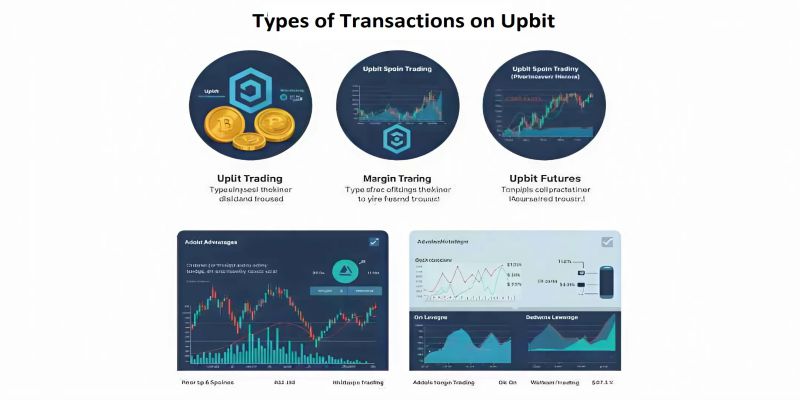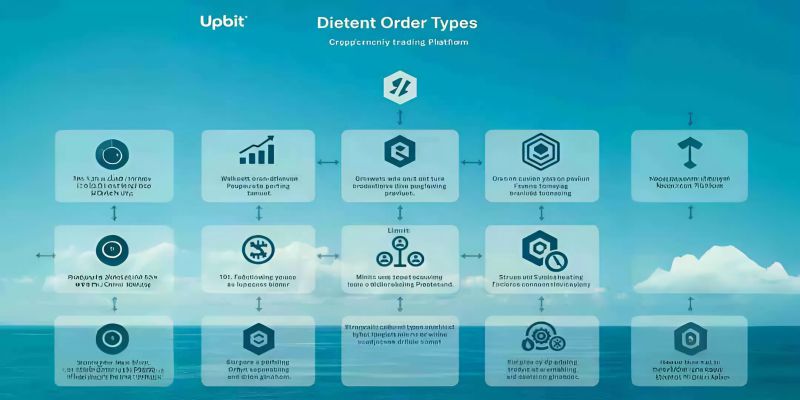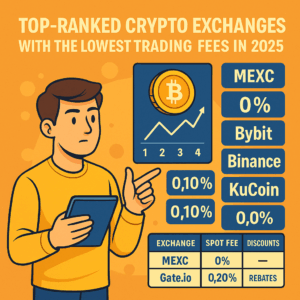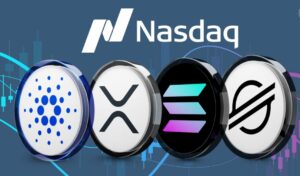
Cryptocurrency trading has become an essential part of the digital economy, offering investors various opportunities to grow their assets. Among the many exchanges available, Upbit stands out as one of the most trusted and widely used platforms, particularly in Asia. This guide provides a detailed overview of Upbit trading types, including transaction types, order options, and fee structures, to help you make informed investment decisions.
Whether you are a beginner or an experienced trader, understanding Upbit trading types will enhance your trading strategy, minimize risks, and optimize profits. This guide will cover everything from basic spot trading to advanced order types and fee-reduction strategies, ensuring you have all the necessary knowledge to trade effectively.
Introduction to Upbit
Before starting to trade on Upbit, you need to understand this platform and the benefits it offers. Upbit is not only one of the largest cryptocurrency exchanges in the world but also stands out with its high-security system, user-friendly interface, and diverse Upbit trading types.
What is Upbit?
Upbit is one of the world’s leading cryptocurrency exchanges, particularly popular in South Korea. Founded in 2017 by Dunamu, Upbit quickly grew into a reputable trading platform with millions of users worldwide. Through its partnership with Bittrex—a well-known U.S. exchange—Upbit ensures safety and high liquidity for investors.
Advantages of Upbit
Upbit offers several outstanding advantages, making it easier for investors to access the cryptocurrency market:
- High Security: Partners with Bittrex to provide a secure trading environment, integrating multiple advanced security layers.
- Diverse Assets: Supports trading of hundreds of cryptocurrencies, including Bitcoin (BTC), Ethereum (ETH), Ripple (XRP), and many others.
- User-friendly Interface: Suitable for both beginners and professional traders, providing advanced technical analysis tools.
- Fast Transaction Speed: Advanced technology enables instant order execution, minimizing transaction latency.
- Mobile App Integration: Easily trade on mobile with the Upbit Mobile application.
- Supports Multiple Markets: This not only allows cryptocurrency pair trading but also offers fiat trading options in certain countries.
- High Liquidity: A Large trading volume ensures easy buying and selling without significantly affecting market prices.
- Professional Customer Support: A dedicated support team is available to answer all user inquiries.

Types of Transactions on Upbit
When trading on Upbit, you will have multiple options depending on your investment needs and strategy. Below are the popular Upbit trading types supported by Upbit.
Upbit Spot Trading
Spot trading is the method of buying and selling digital assets instantly at the market price or a predetermined price. This is the most common form of Upbit trading types, suitable for both new and professional investors.
Advantages:
- Quick and easy execution.
- No risks from leverage or asset liquidation.
- Suitable for both short-term and long-term investors.
- Transparent with no hidden fees.
- Can be used to accumulate assets over the long term.
- Does not require advanced trading knowledge, making it accessible to all users.
Disadvantages:
- No profit amplification tools like leverage.
- Capital growth depends on market fluctuations.
- Profit comes from asset price increases, with no way to earn money when prices drop.
- Cannot utilize speculative strategies as effectively as margin or futures trading.
Upbit Margin Trading
How It Works: Upbit Margin Trading allows users to borrow funds from the exchange to trade with a larger amount than their actual capital, maximizing profits. Users can choose different leverage levels to optimize their Upbit trading type strategy.
Risks and Benefits
- Benefits: Increases profit potential from market fluctuations through leverage.
- Risks: The Possibility of losing the entire capital due to the liquidation mechanism when prices move against predictions.
- Understanding is Key: Using excessive leverage can quickly lead to account liquidation.
- Risk Management: Setting a stop-loss order is crucial to avoid significant losses.
- Not Suitable for Beginners: Margin trading requires deep market knowledge.
- Requires Continuous Market Monitoring: To prevent sudden asset liquidation.
Upbit Futures Trading (If Available)
Upbit Futures Trading involves derivative trading instruments that allow investors to bet on asset price movements without owning them. Upbit trading types include Upbit Futures Trading, which can be used to hedge portfolio risks or capitalize on price fluctuations for profit.
Comparison with Margin Trading
- Futures: Allows trading in both directions (long/short), enabling profit even in a declining market.
- Margin: Primarily relies on borrowing and can lead to liquidation if prices fluctuate significantly.
- Futures Have Higher Risks: But also offer greater profit potential if used correctly.
- Suitable for Experienced Investors: Requires clear strategies and market knowledge.

Types of Orders on Upbit
Choosing the right order type helps optimize your investment strategy. Below are the common order types on Upbit, allowing you to control pricing, transaction speed, and risk levels within Upbit trading types.
Market Order
A market order is executed immediately at the best available price. It ensures fast execution but does not allow control over the final transaction price.
- Advantages: Fast execution, ensuring the trade goes through instantly.
- Disadvantages: The final price may differ from the expected price, especially in volatile markets.
- Best For: Traders who need quick execution without waiting for a specific price.
Limit Order
A limit order allows traders to specify the exact price at which they wish to buy or sell an asset. The order will only be executed if the market reaches the set price.
- Advantages: Provides better control over the transaction price.
- Disadvantages: Execution is not guaranteed if the market does not reach the specified price.
- Best For: Investors who want to buy low or sell high with greater control over pricing.
Stop-Limit Order
A stop-limit order is a combination of a stop order and a limit order, helping to minimize losses or secure profits.
- How It Works: When the asset price reaches the stop price, the system places a limit order.
- Advantages: Helps prevent significant losses by executing trades at a predefined level.
- Disadvantages: If the price moves too quickly, the limit order may not be executed.
- Best For: Traders who need automated risk management.
OCO (One Cancels the Other) Order (If Available)
An OCO order allows traders to place two linked orders: one limit order and one stop-limit order. If one is executed, the other is automatically canceled.
- Advantages: Enables better control over buying/selling by setting profit targets and stop-loss levels simultaneously.
- Disadvantages: Requires careful setup to avoid unintentional order cancellations.
- Best For: Traders who want automated order execution while managing risk.

Trading Fees on Upbit
Before trading, you need to understand the various fees on Upbit trading types to optimize costs and profits.
Transaction Fees
Trading fees are a crucial aspect of cryptocurrency transactions as they directly affect profitability. Upbit trading types come with different fee structures to accommodate various trader profiles and volumes.
- Standard Fees: Upbit charges a trading fee typically between 0.1% and 0.2% per trade.
- Variability Factors: Fees may differ based on account type, trading volume, and promotional programs.
- Maker & Taker Model (If Applicable): Some platforms offer different fees for makers (those who add liquidity) and takers (those who remove liquidity).
Deposit and Withdrawal Fees
In addition to trading fees, deposit and withdrawal costs are essential to consider when moving funds in and out of Upbit. These fees depend on the Upbit trading types you engage with.
- Deposits: Free for most cryptocurrencies, though some may have small fees.
- Withdrawals: Withdrawal fees vary depending on the asset type. For example, Bitcoin withdrawal fees are around 0.0005 BTC, while Ethereum fees differ based on network congestion.
- Fiat Deposits/Withdrawals: If applicable, fiat transactions may incur additional charges based on banking methods and country regulations.
Fee Reduction Programs
Upbit provides several incentives to help investors lower trading costs:
- Reduced Fees for High-Volume Traders: Users trading large amounts may qualify for lower fees.
- VIP User Benefits: Some accounts enjoy special discounts based on trading activity and account status.
- Using Native Tokens (If Available): Some exchanges reduce fees when users pay with the platform’s token, offering up to 50% discounts in some cases.
- Promotional Events & Referral Programs: Periodic events may offer zero-fee trading or cashback incentives.
Conclusion
Trading on Upbit offers many opportunities for investors, from spot trading and margin trading to futures contracts. However, each Upbit trading type carries its risks, so thoroughly researching and applying proper strategies will help optimize profits and protect assets. Before trading, clearly define your investment goals and implement effective risk management to ensure the best experience on Upbit. Understanding Upbit trading types will help you make more informed investment decisions and navigate the market effectively.



























